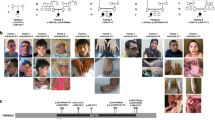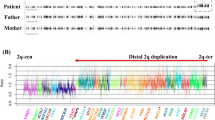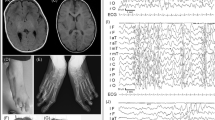Abstract
X-linked forms of mental retardation (MR) affect approximately 1 in 600 males and are likely to be highly heterogeneous1,2,3. They can be categorized into syndromic (MRXS) and nonspecific (MRX) forms. In MRX forms, affected patients have no distinctive clinical or biochemical features. At least five MRX genes have been identified by positional cloning, but each accounts for only 0.5%–1.0% of MRX cases4,5. Here we show that the gene TM4SF2 at Xp11.4 is inactivated by the X breakpoint of an X;2 balanced translocation in a patient with MR. Further investigation led to identification of TM4SF2 mutations in 2 of 33 other MRX families. RNA in situ hybridization showed that TM4SF2 is highly expressed in the central nervous system, including the cerebral cortex and hippocampus. TM4SF2 encodes a member of the tetraspanin family of proteins, which are known to contribute in molecular complexes including β-1 integrins6,7,8. We speculate that through this interaction, TM4SF2 might have a role in the control of neurite outgrowth.
This is a preview of subscription content, access via your institution
Access options
Subscribe to this journal
Receive 12 print issues and online access
$209.00 per year
only $17.42 per issue
Buy this article
- Purchase on Springer Link
- Instant access to full article PDF
Prices may be subject to local taxes which are calculated during checkout




Similar content being viewed by others
Accession codes
Accessions
GenBank/EMBL/DDBJ
References
Herbst, D.S. & Miller, J.R. Nonspecific X-linked MRII: the frequency in British Columbia. Am. J. Med. Genet. 7 , 461–469 (1980).
Glass, I.A. X-linked mental retardation. J. Med. Genet. 28, 361–371 (1991).
Lubs, H.A. et al. XLMR genes: update 1998. Am. J. Med. Genet. 64, 147–157 (1998).
Carrié, A. et al. A novel member of the IL-1 receptor family highly expressed in hippocampus and involved in X-linked mental retardation. Nature Genet. 23, 25–31 ( 1999).
Chelly, J. Breakthroughs in molecular and cellular mechanisms underlying X-linked mental retardation. Hum. Mol. Genet. 81, 1833– 1838 (1999).
Helmer, M.E. Integrin associated proteins. Curr. Opin. Cell Biol. 10, 578–585 (1998).
Maecker, H.T., Todd, S.C. & Levy, S. The tetraspanin superfamily: molecular facilitators. FASEB J. 11, 428–442 ( 1999).
Rubenstein, E. & Boucheix, C. Tetraspans. in Guidebook to the Extracellular Matrix and Adhesion Proteins (eds Kreis, T. & Vale, R.) 20–24 (Oxford University Press, Oxford, 1993).
Li, S.H., McInnis, M.G., Margolis, R.L., Antonarakis, S.E. & Ross, C.A. Novel triplet repeat containing genes in human brain: cloning, expression and length polymorphisms . Genomics 16, 572–579 (1993).
Emi, N. et al. Isolation of a novel cDNA clone showing marked similarity to ME491/CD63 superfamily. Immunogenetics 37, 193– 198 (1993).
Takagi, S. et al. Identification of a highly specific surface marker of T-cell acute lymphoblastic leukemia and neuroblastoma as a new member of the transmembrane 4 superfmily. Int. J. Cancer 61, 706– 715 (1995).
Culbertson, M.R. RNA surveillance. Unforeseen consequences for gene expression, inherited genetic disorders and cancer. Trends Genet. 15, 74–80 (1999).
Mandel, J.L. Towards identification of X-linked mental retardation genes: a proposal. Am. J. Med. Genet. 51, 550–552 (1994).
Milner, B., Squire, L.R. & Kandel, E.R. Cognitive neuroscience and the study of memory. Neuron 20, 445–468 ( 1998).
Tsien, J.Z., Huerta, P.T. & Tonegawa, S. The essential role of hippocampal CA1 NMDA receptor-dependent synaptic plasticity in spatial memory. Cell 87, 1327–1338 (1996).
Bliss, T.V.P. & Collingridge, L.G. A synaptic model of memory: long-term potentiation in the hippocampus. Nature 361 , 31–39 (1993).
Hall, A. RhoGTPases and the actin cytoskeleton. Science 279, 509–514 (1998).
Mueller, B.K. Growth cone guidance: first steps toward a deeper understanding. Annu. Rev. Neurosci. 22, 351–388 (1999).
Cherif, D. et al. Simultaneous localization of cosmids and chromosome R-banding by fluorescence microscopy: application to regional mapping of human chromosome 11. Proc. Natl Acad. Sci. USA 87, 6639– 6643 (1990).
Fernandez, E. et al. Use of chemical clamps in denaturing gradient gel electrophoresis: application in the detection of the most frequent Mediterranean ß -thalassemic mutations. PCR Methods Appl. 3, 122– 124 (1993).
Crumeyrolle-Arias, M. et al. Radioimagers as alternative to film autoradiography for in situ quantitative analysis of 125I-ligand receptor binding and pharmacological studies. Histochem. J. 28, 801– 809 (1996).
Acknowledgements
We thank the patients and other family members for participation; members of the European XLMR consortium and T. Meitinger for contribution to this work and helpful discussions; the Resource Center of the German Human Genome Project at the Max-Planck-Insitute for Molecular Genetics for providing biological material; and members of Banque de cellules de Cassini for technical assistance. This work was supported in part by grants from the Human Frontier Scientific program, INSERM, including an APEX program 4X007E; La Fondation pour la Recherche Médicale; the Association Française contre les Myopathies; and The Fondation Jérôme Lejeune. R.Z. is a recipient of La Fondation pour la Recherche Médicale.
Author information
Authors and Affiliations
Corresponding author
Supplementary information
Rights and permissions
About this article
Cite this article
Zemni, R., Bienvenu, T., Vinet, M. et al. A new gene involved in X-linked mental retardation identified by analysis of an X;2 balanced translocation. Nat Genet 24, 167–170 (2000). https://doi.org/10.1038/72829
Received:
Accepted:
Issue Date:
DOI: https://doi.org/10.1038/72829
This article is cited by
-
Tetraspanin 7 promotes osteosarcoma cell invasion and metastasis by inducing EMT and activating the FAK-Src-Ras-ERK1/2 signaling pathway
Cancer Cell International (2022)
-
Autoimmunity to tetraspanin-7 in type 1 diabetes
Medical Microbiology and Immunology (2020)
-
Tetraspanin 7 and its closest paralog tetraspanin 6: membrane organizers with key functions in brain development, viral infection, innate immunity, diabetes and cancer
Medical Microbiology and Immunology (2020)
-
Tetraspanin1 promotes NGF signaling by controlling TrkA receptor proteostasis
Cellular and Molecular Life Sciences (2020)
-
Channel catfish, Ictalurus punctatus (Rafinesque), tetraspanin membrane protein family: identification, characterization and phylogenetic analysis of tetraspanin 3 and tetraspanin 7 (CD231) transcripts
Fish Physiology and Biochemistry (2012)



